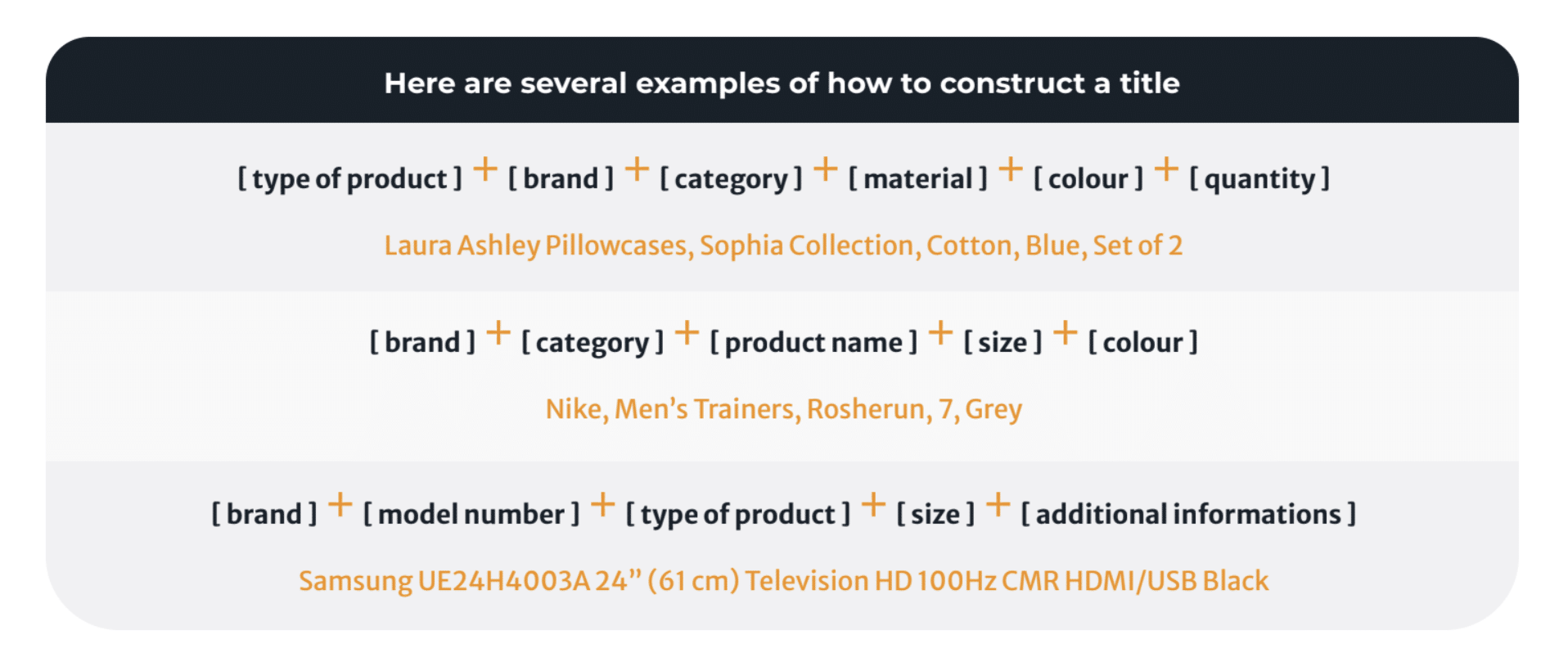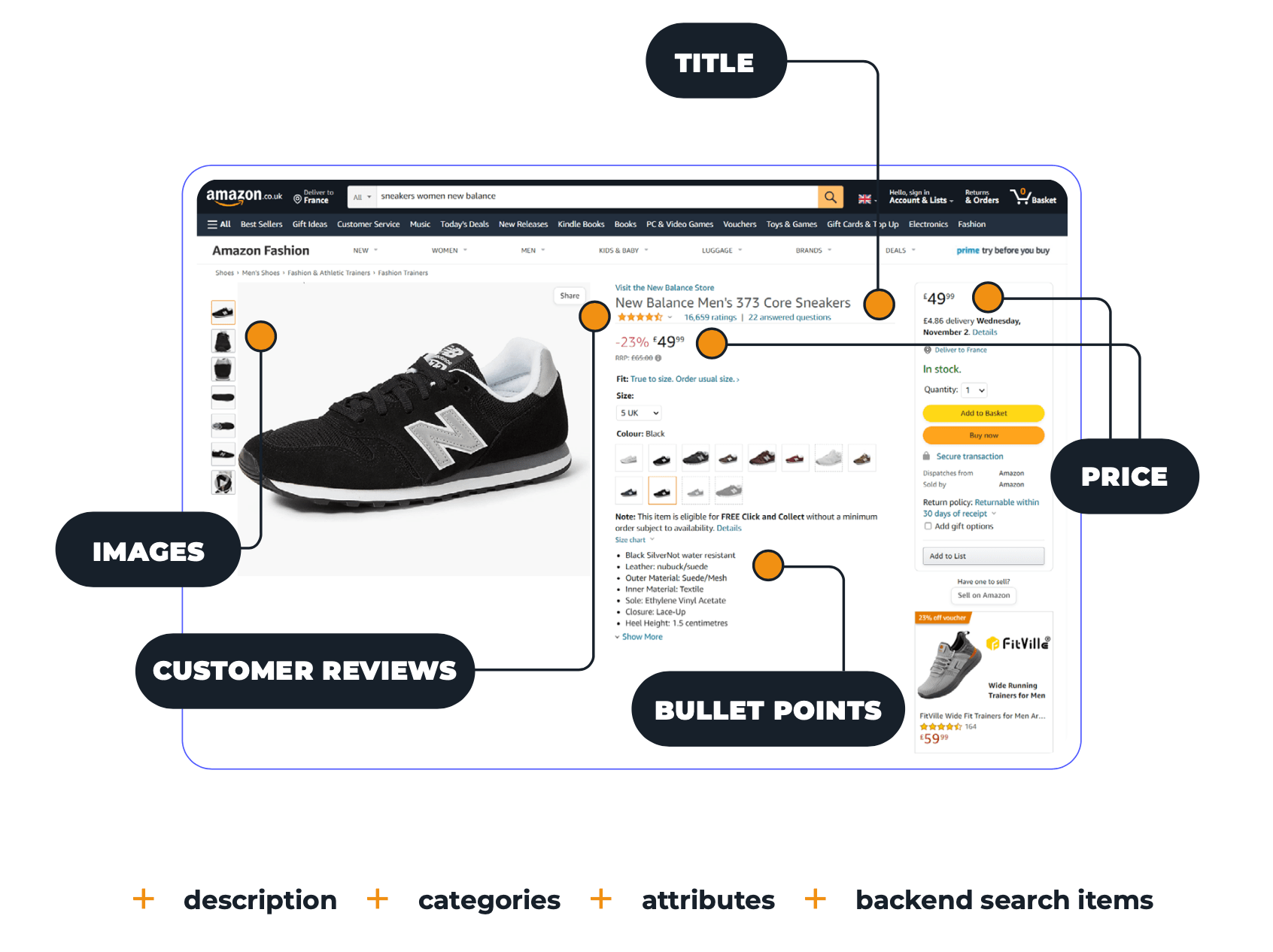5 Tips To Get Your Amazon Product Feed Right
24/04/23
6'
Selling your products on Amazon can be a lucrative opportunity to reach a broad audience (Amazon has more than 310 million customers worldwide) and increase your sales, especially in Europe where Amazon is now present in 11 countries such as France, Germany, Italy, the Netherlands, Spain, but also Sweden, Turkey, or Poland. However, with millions of products available on this marketplace, standing out and getting your products in front of potential customers can be a challenging task. One of the critical factors that can help you succeed on Amazon is having a well-optimised product feed that is accurate and complete.
In this article, we’ll explore how to get your Amazon product feed right and enhance it for maximum visibility and sales.
1/ Optimise Your Product Titles and Descriptions
Product titles (200 characters) and descriptions (max. 2000 characters) are crucial for attracting potential customers and increasing click-through rates. To optimise them, use relevant keywords and phrases that describe your product accurately. Be sure to use your primary keyword at the beginning of your title, as this can help improve your product’s visibility in search results. Also, ensure that your product descriptions are informative and easy to read, highlighting your product’s unique features and benefits and that they comply with Amazon’s guidelines and policies.
Tip: Thanks to Lengow’s automatic rules, you can easily adapt your product titles to suit Amazon’s nomenclature.
Some ideas on where to start:
- Use descriptive keywords in your product titles and descriptions to help potential customers find your product.
- Start your title with the most relevant and essential information, such as the brand name or product type. Make sure that your product’s brand name and manufacturer are correctly spelled and formatted.
- Use bullet points in your product description to make it easy to read and highlight your product’s features and benefits. Due to their proximity to the title, image, price, and Buy Box, bullet points are an essential field for keywords as well as your product’s key features and benefits. They also seem to have more influence on ranking than the description does.
Some examples of possible title constructions:

2/ Optimise Your Product Images
High-quality product images can significantly impact your product’s visibility and sales. Amazon requires that your product images meet specific criteria, including high resolution, proper lighting, and a white background. In terms of formatting, the ideal size is a minimum of 1000×1000 pixels so as to activate the zoom feature. The product must take up at least 85% of the total image and be on a 100% white background. The main photo must not feature any text (however text is allowed on additional images).
To optimise your images for your Amazon product feed, ensure they meet these criteria and accurately depict your product.
More tips:
- Use high-quality images that accurately represent your product and meet Amazon’s image guidelines.
- Use multiple images to showcase your product from different angles and perspectives. Maybe even add a video of the product.
- Use lifestyle images to show your product in use and help potential customers envision themselves using the product.

3/ Use Accurate Product Attributes
Product attributes, such as size, color, and material, are essential for helping customers find and purchase your products. Ensure that your product attributes are accurate and match the product’s description. Precise product attributes can also help improve your product’s visibility in Amazon search results: During the search, attributes such as brand, size, and colours help buyers find your product. It is therefore recommended that you complete all the attributes and not just the mandatory ones.
Example: If you sell coffee machines, the brand and the capacity are attributes that will refine searches.
Keep in mind to:
- Ensure that your product attributes accurately match your product and its description.
- Not only use mandatory but also specific and detailed attributes to make it easier for potential customers to find your product.
- Use Amazon’s recommended attributes for your product category to improve your product’s visibility in search results.
4/ Use Amazon’s Category-Specific Guidelines
Amazon has specific guidelines for each product category, such as clothing, electronics, and home goods. It is important that you follow these guidelines when optimising your Amazon product feed, as this can help improve your product’s visibility.
Tip: Match your product catalogue’s fields to those expected by Amazon. Create an organised and well-structured catalogue by matching your product categories easily with those required by Amazon via “Category Matching” on the Lengow platform.
Key elements:
- Check Amazon’s guidelines for your product category and ensure that your product feed meets all the requirements.
- Use Amazon’s recommended titles and descriptions for your product category to improve your product’s visibility in search results.
- Use category-specific keywords in your product titles and descriptions to help potential customers find your product.
5/ Always Keep an Eye on Your Product Feed Performance
Monitoring your Amazon product feed’s performance is essential for identifying issues and improving your product’s visibility and therefore sales. For example, it is essential to synchronise the indexations of your Amazon feed with your product catalogue updates to thus synchronise your e-commerce site’s stock with Amazon’s. You will then avoid putting items that are no longer in stock up for sale.
Also, systematically check your error integration reports (delivered by feed management tools such as Lengow) after you upload a feed to ensure your products are set up correctly (product feeds) or updated correctly (offer feeds). These reports only contain products that have not been accepted by Amazon. Amazon specifies the reason for the error message, so you can quickly correct and reupload the product.
Use Amazon’s performance metrics to monitor your product’s performance, including click-through rates, conversion rates, and Buy Box percentage. Use this information to identify areas for improvement and make necessary changes to your product feed.
Your e-commerce library
Sign up for our newsletter
By submitting this form you authorize Lengow to process your data for the purpose of sending you Lengow newsletters . You have the right to access, rectify and delete this data, to oppose its processing, to limit its use, to render it portable and to define the guidelines relating to its fate in the event of death. You can exercise these rights at any time by writing to dpo@lengow.com

Trending Posts
Marketing channels
ChatGPT Ads and advertising on GenAI Search Engines: what you need to know
Advertising on generative AI-based search engines (GenAI) marks a new era in digital marketing. After two decades dominated by traditional…
22/05/25
6'
Marketing channels
Reddit and Social Commerce: When Users Take Back Control
Before buying anything, we compare. We hesitate. And more and more often, we end up typing the product name followed…
30/06/25
8'
Marketing channels
How to Sell on TikTok in 2025: The Ultimate Guide to Success
To sell or not to sell on TikTok? That remains a question many brands ask themselves. But here’s what you…
03/02/25
7'
E-commerce Trends
E-Commerce 2025: The New Rules of Digital Retail
What’s going on in e-commerce? A lot. If 2024 was the year brands got comfortable with marketplaces, AI tools, and…
11/07/25
8'
Marketing channels
Omnichannel Strategy: The Best Examples of Successful Brands
Consumers interact with brands through multiple channels, including online, in-store, and mobile apps. More than 90% of consumers expect a…
04/04/25
5'




